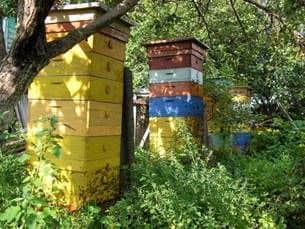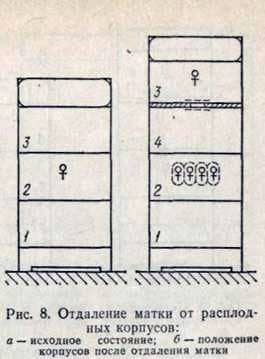
The work is done in late May – early June, when the gardens bloom and the yellow acacia. In the evening, in cool weather, it is necessary to warm up the pavilion to 20-25 њ C.
Having a good development of families, it is necessary to make a second rearrangement of the buildings in the main families: to put the third building on the main families and the second one to the wintering layers if it is necessary to increase the number of the apiary families.
In new buildings, install (for the main families) 6 small-honeycomb honeycombs or pour 3-4 liters of syrup in them. Free space in the middle of the body filled with frames with a wax – 6 on the body.
In summer weather, if there are not enough honeycombs for the main families, you can put the shells, completely filled with frames with a wax, except the extreme ones. Instead of the empty housings, place the remaining cases in a frame with a wax in the center of the brood nest. The third corps in the main families is put on top.

If the weather is cold (non-flying) and there are retired families with good uterus, then it is necessary to place in them 2 frames of printed brood from strong families or combine with reserve layers.
Sealed drone brood from the building frames is cut out, and the frames are again placed in the same place.
After staging the third building in the main families, there should be about 15 kg of feed and 2-3 frames with perga.
A smaller amount of feed during the spring development period gives a weak offspring, and the uterus shortens the oviposition. The flaps open completely.
When preparing honeycombs for installation in new cases, it is necessary to cut off (with a hot apiary knife) those parts of them that protrude beyond the upper bar. This operation will make them suitable for egg laying and better detachment of the wax.
Bees of Carpathian breed well build a wax which they put through one honeycomb and only in the brood part of the nest.

After the spread of varroatosis, there was an opinion about the inadmissibility of rearranging the frames with a sealed brood from one family to another. Otherwise, they say, this will result in the entire apiary being re-emptied. This is true only for cases when the degree of defeat of families is very different.
If they are followed by the same care with the simultaneous carrying out of identical therapeutic measures, then the degree of destruction of the bees by the tick will be approximately equal, that is insignificant.
Consequently, and rearrangement of frames with sealed brood from one family to another at this stage of development will not change the situation.
In a strong family at the end of May there should be 3-4 honeycombs of open brood, 5-6 honeycombs sealed and 20-22 bee-streets in a multi-hull beehive.
To destroy the mite, which is on bees, they are fumigated. At the same time, regular cleaning of the pallet, lubrication and planting of the plants causing the scree of the mite continues.
You can not allow the hibernating honeycombs to come into contact with the remnants of honey in honey houses, since they can contain sugar beet processed by bees. If in the autumn bees were fed syrup with the preparation KAS-81, prepared on the basis of wormwood, then even a small amount of it can give the commodity honey bitterness.
Индийские пчелы. Выделка шкур раствор.
Contents of bees in the pavilion